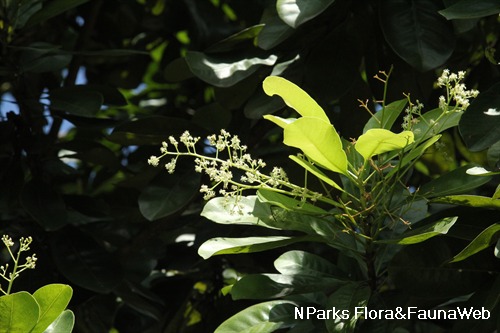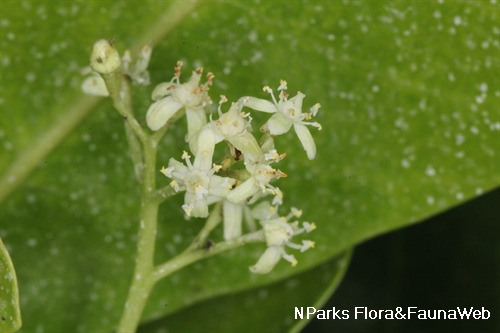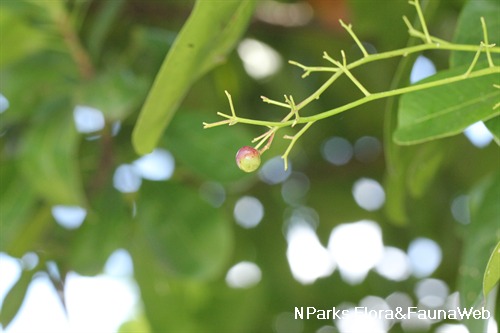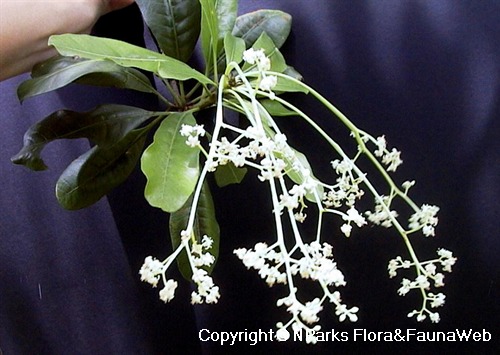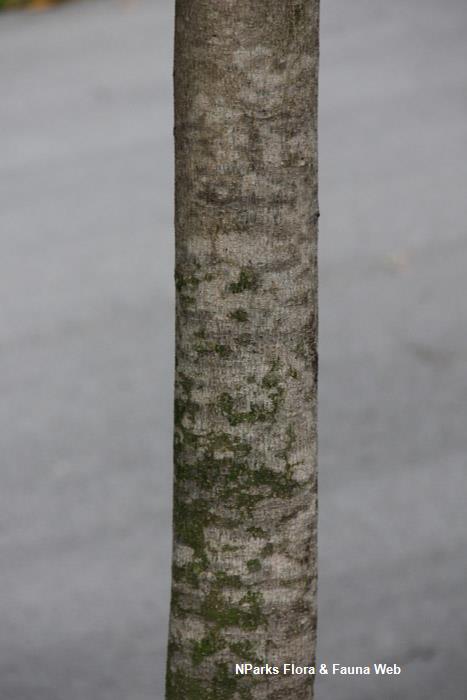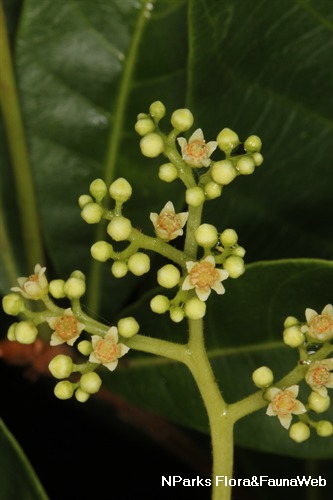_lowres.jpg)
Back
Buchanania arborescens (Blume) Blume
| Family Name: | Anacardiaceae |
| Synonyms: | Buchanania florida, Buchanania lucida |
| Common Name: | Sparrows' Mango, Otak Udang, Katak Udang, Ketak Udang, Puah Pipit, Puan, Terentang Tikus |
Buchanania arborescens or Sparrows' Mango is a large tree of up to 35 m tall. It has leathery oval to narrowly egg or drop-shaped leaves, small cream white flowers and red lens-shaped fruit. Sparrow's Mango is often found in parks and large gardens due to its tolerance to roadside conditions, adaptable to a wide range of soils from coastal, sandy to muddy.
Name
Classifications and Characteristics
| Plant Division | Angiosperms (Flowering Seed Plants) (Dicotyledon) |
|---|---|
| Plant Growth Form | Tree (Big (>30m)) |
| Lifespan (in Singapore) | Perennial |
| Mode of Nutrition | Autotrophic |
| Plant Shape | Rounded, Irregular |
| Maximum Height | 35 m |
Biogeography
| Native Distribution | China, Taiwan, Myanmar, Andaman Islands, Indochina, Thailand, throughout Malesia (including Singapore) to New Britain (Papua New Guinea), Solomons Islands, and Australia |
|---|---|
| Native Habitat | Terrestrial (Primary Rainforest, Secondary Rainforest, Coastal Forest, Freshwater Swamp Forest, Riverine) |
| Preferred Climate Zone | Tropical, Sub-Tropical / Monsoonal |
| Local Conservation Status | Native to Singapore (Least Concern (LC)) |
Description and Ethnobotany
| Growth Form | It is a tree up to 35 m tall. Buttresses up to 1 m high may also be present sometimes. When the tree is flowering, the plant is easily noticed by its distinct, creamy white coloured crown. |
|---|---|
| Foliage | Its spirally arranged, stalked leaves have leathery leaf blades that are green, oval to narrowly egg-shaped or drop-shaped, and 4–35 by 1.8–9.5 cm, with a blunt tip, and network-like venation. |
| Flowers | Its flowering shoots are 5.5–22 cm long, and bear cream-white flowers. |
| Fruit | Its fruits are lens-shaped, red tinged green, and up to 10 mm wide. |
| Habitat | It grows in lowland secondary forests, along riverbanks, near beaches, peat swamps, and on hills, up to 500 m altitude. It occurs locally in Western Catchment, Bukit Timah Nature Reserve, Mandai, Nee Soon swamp forest, Pasir Panjang, Sentosa, Pulau Pawai, and Pulau Tekong. |
| Associated Fauna | It is the preferred local food plant for caterpillars of the moth, Phyllocnistis exiguella. Its flowers are insect-pollinated. |
| Cultivation | It can be propagated by seed. |
| Etymology | Latin Buchanania, after F. Buchanan-Hamilton (d. 1829), a Scottish naturalist who first described but not named any one of these Buchanania trees from Myanmar in 1798; Latin arborescens, referring to the tree-like habit of the plant |
| Ethnobotanical Uses | Food (Herb or Spice) Medicinal: Headaches can be treated using a poultice of pounded leaves. Timber & Products: The wood, though of inferior quality, is used for a variety of uses such as boxes, cases, furniture, interior finishing, light construction, joints, roof supports, and veneers. Cultural / Religious: Heritage Tree : There is currently one individual of Buchanania arborescens listed as a Heritage Tree in Singapore. It can be found at Changi. To find out more about this tree, please visit the Heritage Tree Register. Others: The bark contains a small amount of tannin, and is used to strengthen fishing nets. |
Landscaping Features
| Landscaping | This tree may be suitable for parks and large gardens, and may be able to tolerate roadside conditions. Its cream-white flowers and dense mango-like foliage make it attractive. It can tolerate a wide range of soil conditions, so making it suitable for most sites from coastal to inland, sandy to muddy situations. |
|---|---|
| Desirable Plant Features | Ornamental Flowers, Ornamental Form |
| Landscape Uses | General, Suitable for Roadsides, Parks & Gardens, Small Gardens, Coastal, Riverine |
Fauna, Pollination and Dispersal
| Fauna Pollination Dispersal Associated Fauna | Bird-Attracting (Fruits), Caterpillar Moth Food Plant (Leaves) |
|---|---|
| Pollination Method(s) | Biotic (Fauna) |
| Seed or Spore Dispersal | Biotic (Fauna) |
Plant Care and Propagation
| Light Preference | Full Sun |
|---|---|
| Water Preference | Moderate Water, Lots of Water |
| Plant Growth Rate | Moderate |
| Rootzone Tolerance | Moist Soils, Waterlogged Soils (Drains Site), Well-Drained Soils, Fertile Loamy Soils |
| Propagation Method | Seed |
Foliar
| Foliage Retention | Evergreen |
|---|---|
| Mature Foliage Colour(s) | Green |
| Mature Foliage Texture(s) | Leathery |
| Foliar Type | Simple / Unifoliate |
| Foliar Arrangement Along Stem | Alternate, Spiral |
| Foliar Attachment to Stem | Petiolate |
| Foliar Shape(s) | Non-Palm Foliage (Obovate) |
| Foliar Venation | Pinnate / Net |
| Leaf Area Index (LAI) for Green Plot Ratio | 3.0 (Tree - Intermediate Canopy) |
Non - Foliar and Storage
| Stem Type & Modification | Woody |
|---|---|
| Root Type | Underground (Tap Root) |
Floral (Angiosperm)
| Flower & Plant Sexuality | Bisexual Flowers , Bisexual Flowers |
| Flower Colour(s) | White, Cream / Off-White |
|---|
| Flower Grouping | Cluster / Inflorescence |
| Flower Location | Axillary |
| Flower Symmetry | Radial |
| Flowering Habit | Polycarpic |
Fruit, Seed and Spore
| Mature Fruit Colour(s) | Red |
|---|---|
| Fruit Classification | Simple Fruit |
| Fruit Type | Fleshy Fruit , Non-Accessory Fruit |
References
| References | Chayamarit, K (2010). Anacardiaceae. Flora of Thailand, 10(3), pp. 270 - 272. Bangkok: Forest Herbarium, Royal Forest Department. |
|---|
Image Repository
Others
| Master ID | 1467 |
|---|---|
| Species ID | 2760 |
| Flora Disclaimer | The information in this website has been compiled from reliable sources, such as reference works on medicinal plants. It is not a substitute for medical advice or treatment and NParks does not purport to provide any medical advice. Readers should always consult his/her physician before using or consuming a plant for medicinal purposes. |

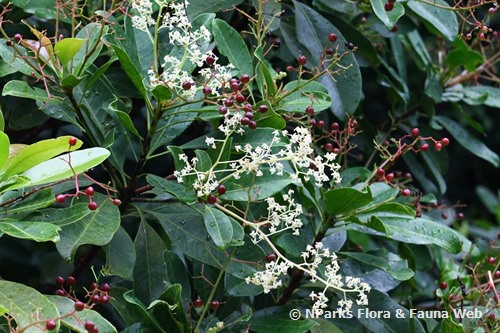
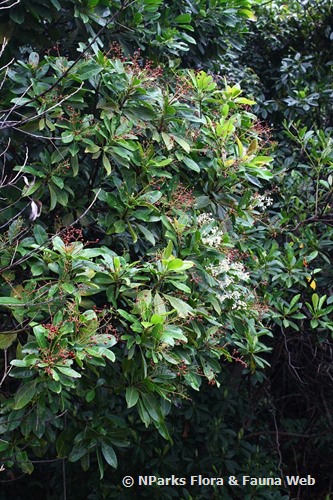
_lowres.jpg)
_lowres.jpg)
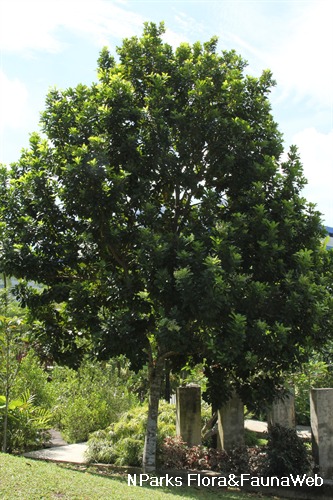
_lowres.jpg)
_lowres.jpg)
_lowres.jpg)
